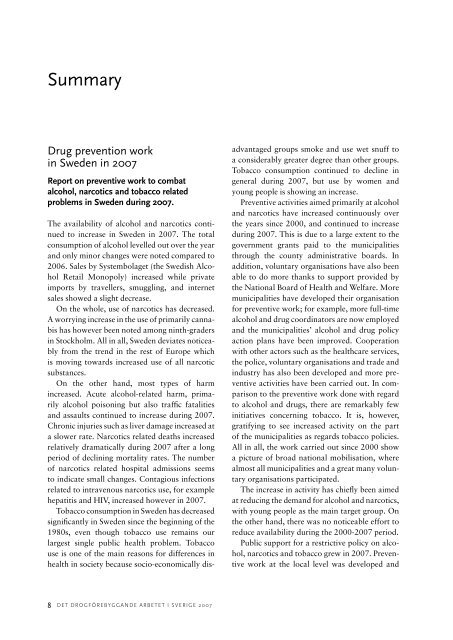Det drogförebyggande arbetet i Sverige 2007, 3.45 MB - Statens ...
Det drogförebyggande arbetet i Sverige 2007, 3.45 MB - Statens ...
Det drogförebyggande arbetet i Sverige 2007, 3.45 MB - Statens ...
Create successful ePaper yourself
Turn your PDF publications into a flip-book with our unique Google optimized e-Paper software.
Summary<br />
Drug prevention work<br />
in Sweden in <strong>2007</strong><br />
Report on preventive work to combat<br />
alcohol, narcotics and tobacco related<br />
problems in Sweden during <strong>2007</strong>.<br />
The availability of alcohol and narcotics continued<br />
to increase in Sweden in <strong>2007</strong>. The total<br />
consumption of alcohol levelled out over the year<br />
and only minor changes were noted compared to<br />
2006. Sales by Systembolaget (the Swedish Alcohol<br />
Retail Monopoly) increased while private<br />
imports by travellers, smuggling, and internet<br />
sales showed a slight decrease.<br />
On the whole, use of narcotics has decreased.<br />
A worrying increase in the use of primarily cannabis<br />
has however been noted among ninth-graders<br />
in Stockholm. All in all, Sweden deviates noticeably<br />
from the trend in the rest of Europe which<br />
is moving towards increased use of all narcotic<br />
substances.<br />
On the other hand, most types of harm<br />
increased. Acute alcohol-related harm, primarily<br />
alcohol poisoning but also traffic fatalities<br />
and assaults continued to increase during <strong>2007</strong>.<br />
Chronic injuries such as liver damage increased at<br />
a slower rate. Narcotics related deaths increased<br />
relatively dramatically during <strong>2007</strong> after a long<br />
period of declining mortality rates. The number<br />
of narcotics related hospital admissions seems<br />
to indicate small changes. Contagious infections<br />
related to intravenous narcotics use, for example<br />
hepatitis and HIV, increased however in <strong>2007</strong>.<br />
Tobacco consumption in Sweden has decreased<br />
significantly in Sweden since the beginning of the<br />
1980s, even though tobacco use remains our<br />
largest single public health problem. Tobacco<br />
use is one of the main reasons for differences in<br />
health in society because socio-economically dis-<br />
8 <strong>Det</strong> DRoGFöRebyGGANDe ARbetet I SveRIGe <strong>2007</strong><br />
advantaged groups smoke and use wet snuff to<br />
a considerably greater degree than other groups.<br />
Tobacco consumption continued to decline in<br />
general during <strong>2007</strong>, but use by women and<br />
young people is showing an increase.<br />
Preventive activities aimed primarily at alcohol<br />
and narcotics have increased continuously over<br />
the years since 2000, and continued to increase<br />
during <strong>2007</strong>. This is due to a large extent to the<br />
government grants paid to the municipalities<br />
through the county administrative boards. In<br />
addition, voluntary organisations have also been<br />
able to do more thanks to support provided by<br />
the National Board of Health and Welfare. More<br />
municipalities have developed their organisation<br />
for preventive work; for example, more full-time<br />
alcohol and drug coordinators are now employed<br />
and the municipalities’ alcohol and drug policy<br />
action plans have been improved. Cooperation<br />
with other actors such as the healthcare services,<br />
the police, voluntary organisations and trade and<br />
industry has also been developed and more preventive<br />
activities have been carried out. In comparison<br />
to the preventive work done with regard<br />
to alcohol and drugs, there are remarkably few<br />
initiatives concerning tobacco. It is, however,<br />
gratifying to see increased activity on the part<br />
of the municipalities as regards tobacco policies.<br />
All in all, the work carried out since 2000 show<br />
a picture of broad national mobilisation, where<br />
almost all municipalities and a great many voluntary<br />
organisations participated.<br />
The increase in activity has chiefly been aimed<br />
at reducing the demand for alcohol and narcotics,<br />
with young people as the main target group. On<br />
the other hand, there was no noticeable effort to<br />
reduce availability during the 2000-<strong>2007</strong> period.<br />
Public support for a restrictive policy on alcohol,<br />
narcotics and tobacco grew in <strong>2007</strong>. Preventive<br />
work at the local level was developed and

















